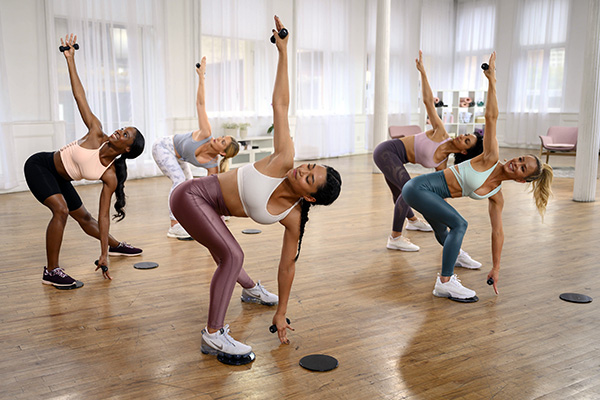
xr:d:DAF9Sv20Cjg:126,j:4176383674127048111,t:24030710
Pilates can aid in weight loss by building muscle and improving overall body tone. It enhances metabolism and promotes a leaner physique.
Pilates is a low-impact exercise that focuses on strengthening muscles while improving postural alignment and flexibility. It is not only effective for core strength but also for full-body conditioning. By incorporating Pilates into your fitness routine, you can increase muscle mass, which helps to boost metabolism.
This, in turn, aids in burning calories more efficiently, contributing to weight loss. Pilates also enhances body awareness, encouraging better eating habits and lifestyle choices. Regular practice can lead to a leaner, more toned body, making it a valuable addition to any weight loss plan. Whether you are a beginner or an advanced practitioner, Pilates offers versatile workouts to meet your needs.

Credit: evidation.com
How Pilates Evolves?
Pilates is not just a fitness routine; it’s a lifestyle choice that many people embrace. It’s a powerful tool for weight loss, helping you build strength, flexibility, and mindfulness. This exercise method focuses on controlled movements, making it perfect for anyone, regardless of age or fitness level. Let’s dive into the world of Pilates and discover how it can transform your body and mind.
History Of Pilates
Pilates was created by Joseph Pilates in the early 20th century. Born in 1883, Joseph was a sickly child who suffered from asthma and other ailments. Determined to improve his health, he studied various forms of exercise and developed a unique method.
By World War I, Joseph Pilates had refined his techniques. He used them to help injured soldiers recover. His approach combined elements of yoga, martial arts, and ancient Greek exercises. He called his method “Contrology,” emphasizing the mind’s control over the body.
After the war, Pilates moved to New York City. He opened a studio and began teaching his method. It quickly gained popularity among dancers and athletes, known for its ability to enhance performance and prevent injuries.
Today, Pilates is practiced worldwide. It has evolved to include various styles and equipment, but the core principles remain the same. Pilates emphasizes core strength, flexibility, and controlled breathing.
Core Principles
Pilates is built on six core principles. These principles guide every movement and exercise, ensuring maximum benefit and safety.
- Breathing: Proper breathing is essential in Pilates. It helps oxygenate the muscles and improve concentration.
- Concentration: Focus your mind on every movement. This ensures precision and effectiveness.
- Control: Every action in Pilates is controlled. This prevents injuries and enhances muscle engagement.
- Centering: Pilates exercises originate from the body’s core. This area is often called the “powerhouse.”
- Precision: Perform each movement with accuracy. This improves muscle strength and coordination.
- Flow: Movements in Pilates are smooth and fluid. This creates a sense of harmony and balance in the body.
These principles are the foundation of Pilates. They ensure that each session is effective and transformative. By focusing on these core values, you’ll achieve better results and a deeper connection with your body.
Benefits Of Pilates
Pilates offers numerous benefits for those aiming for weight loss. This low-impact exercise strengthens muscles, improves flexibility, and enhances overall well-being. Let’s explore the physical and mental benefits of Pilates in detail.
Physical Benefits
Pilates provides a wide range of physical benefits that support weight loss. Here are some key advantages:
- Improved Muscle Tone: Pilates targets various muscle groups, helping to tone and strengthen them.
- Increased Flexibility: The exercises promote flexibility, making your body more agile.
- Enhanced Posture: Regular practice improves posture, reducing the risk of back pain.
- Boosted Core Strength: Pilates focuses on the core, leading to stronger abs and lower back.
- Better Balance: It enhances balance, which is crucial for overall fitness.
Here’s a table summarizing the physical benefits:
| Benefit | Description |
|---|---|
| Muscle Tone | Strengthens and tones various muscle groups |
| Flexibility | Increases agility and range of motion |
| Posture | Improves posture, reducing back pain |
| Core Strength | Focuses on strengthening abs and lower back |
| Balance | Enhances overall body balance |
Mental Benefits
Besides physical advantages, Pilates also offers significant mental benefits. These include:
- Stress Reduction: Pilates helps in reducing stress levels, promoting relaxation.
- Improved Focus: The exercises require concentration, which enhances mental clarity.
- Better Sleep: Regular practice can lead to improved sleep patterns.
- Enhanced Mood: Pilates releases endorphins, lifting your mood and combating depression.
- Increased Mindfulness: Focusing on breathing and movement increases mindfulness.
Pilates Vs. Other Workouts
Pilates has gained popularity as a low-impact workout that can help with weight loss. It’s often compared to other workouts like running, cycling, or weight lifting. Understanding how Pilates stacks up against these exercises can help you decide what’s best for your fitness goals.
Comparing Caloric Burn
Caloric burn is a key factor in weight loss. Different workouts burn calories at different rates. Here’s a comparison:
| Workout Type | Calories Burned per Hour |
|---|---|
| Pilates (Beginner) | 170-250 |
| Pilates (Advanced) | 250-450 |
| Running | 600-800 |
| Cycling | 500-700 |
| Weight Lifting | 200-400 |
Pilates burns fewer calories compared to running or cycling. Yet, it still offers a good burn, especially for those who are new to exercise. Advanced Pilates can be quite challenging and can burn nearly as many calories as weight lifting.
Pilates may not be the fastest way to burn calories, but it builds muscle tone and improves posture. These benefits contribute to weight loss over time. Regular Pilates sessions can enhance your overall fitness and help you stay active.
Impact On Flexibility
Flexibility is another important aspect of fitness. Pilates is well-known for enhancing flexibility. Here’s how it compares to other workouts:
- Pilates: Focuses on stretching and lengthening muscles. Improves flexibility through controlled movements and poses.
- Running: Limited impact on flexibility. Primarily a cardiovascular workout.
- Cycling: Can tighten muscles, especially the hamstrings and calves. Needs complementary stretching exercises.
- Weight Lifting: Builds muscle strength. Can reduce flexibility if not paired with stretching routines.
Pilates offers a balanced approach to fitness. It combines strength and flexibility. This makes it a superior choice for those seeking to improve their range of motion and muscle elasticity.
Regular Pilates practice can help prevent injuries by keeping muscles and joints flexible. This is crucial for overall health and well-being. Pilates exercises are designed to work the entire body, promoting balanced muscle development and joint health.

Credit: www.nutrisense.io
Essential Pilates Techniques
Pilates is a fantastic way to lose weight and improve your overall fitness. Understanding the essential Pilates techniques can make a huge difference in your journey. These techniques are key to getting the most out of your Pilates workouts. Let’s dive into some of the most important techniques.
Breathing Techniques
Breathing is a core aspect of Pilates. Proper breathing techniques help you engage your muscles and improve your focus. Here are some key points:
- Diaphragmatic Breathing: This technique involves deep breathing into the diaphragm. It helps to oxygenate your blood and energize your body.
- Lateral Breathing: Focus on expanding your rib cage sideways while keeping your abdomen still. This allows for deeper breaths and better muscle engagement.
- Inhale to Prepare: Always inhale to prepare for a movement. This helps to set your mind and body in sync.
- Exhale to Execute: Exhale during the exertion phase of an exercise. This provides more power and control.
Using these breathing techniques, you can enhance your Pilates practice. You will find it easier to perform exercises and maintain your energy levels. Breathing correctly also reduces stress and improves mental clarity. Incorporate these techniques into your daily routine for the best results.
Posture Alignment
Proper posture alignment is crucial in Pilates. It ensures that you perform exercises safely and effectively. Here are some tips for maintaining good posture:
- Neutral Spine: Always maintain a neutral spine. This means keeping the natural curve of your back.
- Engage Your Core: Pull your belly button towards your spine. This engages your core muscles and protects your lower back.
- Shoulder Position: Keep your shoulders relaxed and down. Avoid hunching them up towards your ears.
- Head Alignment: Your head should be in line with your spine. Avoid jutting your chin forward or tilting your head back.
These posture tips can help you avoid injuries and get the most out of each movement. Good alignment improves muscle efficiency and enhances the overall effectiveness of your workout. Practice these tips regularly to see significant improvements in your form and performance.
Creating A Routine
Pilates is a fantastic exercise for weight loss. It helps to build lean muscle, improve flexibility, and boost metabolism. Creating a routine is essential to see consistent results. A well-structured plan ensures you stay motivated and achieve your fitness goals.
Weekly Schedule
Consistency is key to success with Pilates. A weekly schedule helps you stay on track. Here’s a simple plan to follow:
- Monday: 45 minutes of Pilates focusing on core strength.
- Tuesday: 30 minutes of cardio combined with 15 minutes of stretching.
- Wednesday: 45 minutes of Pilates targeting arms and legs.
- Thursday: 30 minutes of light cardio and 15 minutes of relaxation exercises.
- Friday: 45 minutes of full-body Pilates workout.
- Saturday: Rest day or gentle yoga session.
- Sunday: 30 minutes of Pilates and 15 minutes of meditation.
Following this schedule ensures you work on different muscle groups. It also provides time for rest and recovery. Adjust the duration based on your fitness level. Beginners can start with shorter sessions. As you progress, gradually increase the time.
Equipment Needed
Pilates requires minimal equipment. Here’s a list of essentials:
- Mat: A good quality mat provides comfort and prevents slipping.
- Resistance Bands: These add resistance and help build strength.
- Pilates Ball: Great for core exercises and improving balance.
- Foam Roller: Helps with stretching and muscle recovery.
- Small Weights: Useful for adding intensity to workouts.
Investing in quality equipment makes your workouts more effective. You don’t need everything at once. Start with a mat and gradually add other items as you progress. Use household items as substitutes if needed.
Having the right equipment enhances your Pilates experience. It ensures you perform exercises correctly and safely. This leads to better results and keeps you motivated.

Credit: www.beachbodyondemand.com
Common Mistakes
Pilates is a great workout for weight loss. It helps burn calories, improves flexibility, and builds core strength. But many people make mistakes that hinder their progress. Knowing these common mistakes can help you get the most out of your Pilates sessions.
Overdoing It
Many think that doing more Pilates will lead to faster weight loss. This is a common misconception. Overdoing Pilates can lead to burnout and injuries. Here are some signs you might be overdoing it:
- Feeling exhausted after every session
- Experiencing constant muscle soreness
- Having difficulty performing daily tasks
Balance is key. Rest days are crucial for muscle recovery and growth. A good routine might include:
| Day | Activity |
|---|---|
| Monday | Pilates |
| Tuesday | Light cardio or rest |
| Wednesday | Pilates |
| Thursday | Strength training |
| Friday | Pilates |
| Saturday | Rest |
| Sunday | Light cardio or rest |
Listening to your body is essential. If you feel pain or extreme fatigue, take a break. Pilates should make you feel energized, not drained.
Ignoring Form
Proper form is crucial in Pilates. Ignoring form can lead to injuries and less effective workouts. Here are some tips to maintain good form:
- Engage your core: Always keep your core muscles tight.
- Breathe correctly: Inhale through the nose, exhale through the mouth.
- Align your spine: Keep your back straight to avoid strain.
Many beginners make these common form mistakes:
- Arching the back
- Not engaging the core
- Incorrect breathing
Using a mirror can help you check your form. Taking a class with a certified instructor can provide valuable feedback. Here is a simple checklist to follow during your Pilates sessions:
| Check | Description |
|---|---|
| Core engagement | Is your core tight? |
| Breathing | Are you breathing correctly? |
| Spine alignment | Is your back straight? |
Paying attention to form not only prevents injuries but also ensures you get the most out of each exercise. Good form leads to more effective workouts and better results.
Getting Started
Pilates is a fantastic way to lose weight while improving your flexibility and strength. It’s suitable for all fitness levels and can be done at home or in a class. If you’re new to Pilates, this guide will help you get started.
Finding Classes
Joining a Pilates class can provide structure and motivation. Here are some tips to help you find the right class:
- Local Gyms: Many gyms offer Pilates classes. Check their schedule and see what fits your routine.
- Specialized Studios: Pilates studios focus solely on Pilates. They often have expert instructors.
- Community Centers: These centers often provide affordable classes for beginners.
When searching for a class, consider the following:
| Criteria | Details |
|---|---|
| Class Size | Smaller classes offer more personalized attention. |
| Instructor Experience | Look for certified and experienced instructors. |
| Class Schedule | Find a class that fits your availability. |
Trying different classes can help you find the one that suits you best. Don’t hesitate to ask questions or seek recommendations from friends.
Online Resources
Online resources make it easy to practice Pilates from the comfort of your home. Here are some options to explore:
- YouTube: Many fitness channels offer free Pilates workouts. Search for “beginner Pilates” to get started.
- Fitness Apps: Apps like Peloton, Daily Burn, and Glo provide Pilates routines tailored to different levels.
- Subscription Services: Websites like Pilates Anytime offer a vast library of classes for a monthly fee.
When choosing an online resource, consider:
- Instructor Credentials: Ensure the instructors are certified and experienced.
- Video Quality: High-quality videos make it easier to follow along.
- Variety: Look for platforms that offer various workouts to keep things interesting.
Consistency is key. Set a schedule and stick to it. Even short sessions can make a big difference over time.
Frequently Asked Questions
Can Pilates Help With Weight Loss?
Yes, Pilates can aid in weight loss. It strengthens core muscles, enhances flexibility, and improves posture. Combined with a balanced diet, it can help burn calories and boost metabolism.
How Often Should I Do Pilates For Weight Loss?
For effective weight loss, aim to practice Pilates 3-4 times a week. Consistency is key to seeing results. Pair it with cardio exercises and a healthy diet for best outcomes.
What Are The Best Pilates Exercises For Weight Loss?
Effective Pilates exercises for weight loss include Plank, Teaser, and Leg Circles. These target multiple muscle groups, enhancing calorie burn. Incorporating these into your routine can help achieve weight loss goals.
Is Pilates Better Than Cardio For Weight Loss?
Pilates and cardio serve different purposes. Cardio burns more calories quickly, while Pilates strengthens muscles and improves flexibility. Combining both can provide balanced fitness benefits and support weight loss efforts.
Conclusion
Pilates offers a fantastic way to lose weight while improving flexibility and strength. This low-impact workout supports sustainable weight loss and overall wellness. Commit to regular sessions for effective results. Remember, consistency is key. Start your Pilates journey today and experience the transformative benefits for both body and mind.









